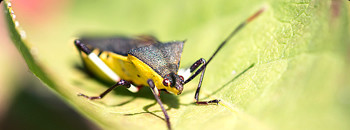As we nestle in to the warmth and comfort of our homes this fall and winter season, remember that pests are also looking for a warm and safe place to spend the winter. Don’t let your home become a haven for unwanted roommates. As the cooler weather approaches, you can keep a safe, pest-free home by implementing the easy I.N.S.P.E.C.T. process.
Today kicks off National Inspect and Protect Week, a week designed to provide you with all the information you need to identify, control, and prevent pests from entering your home environment. Each day this week, we will introduce you to a new step in the process and teach you how to properly apply it. Today, we will start with step one—Investigate.
When investigating your home to make sure it is keeping pests out and not inviting them in, it is important to consider the many ways pests can access your living quarters.
Start off by investigating the perimeter of your home. Pests naturally migrate to water and standing water in bird baths, garbage bucks, gutter lines, and wheel barrows so they often serve as popular breeding grounds for insects like mosquitoes. It is important to remove all standing water from around the home.
Plants and shrubbery directly in contact with your home provide easy access and direct routes for ants and other small pests. It is smart to leave about 18 inches between the trellis and the exterior of your home to avoid these problems.
While inspecting, you may think your home is closed up tight, but it is important to realize that most pests, such as ants, spiders, and roaches only need crawlspace about one quarter of an inch to enter homes. The untrained eye often overlooks these entrances, but carefully searching for small holes in screens, window seals, and in the structure of your home might help you prevent invaders from wiggling their way inside.
Once inside your home, these pests will be on the hunt for food and water. It may seem simple, but keeping your kitchen clean and crumb-free is a good pest prevention technique. Sweeping and dusting routinely will prevent pests from being attracted to any crumbs that may have fallen. If there isn’t a source of food or water in your home, these creepy crawlers cannot survive.
Investigating your home is the most important thing you can do to protect it from unwanted pests and surprises. Using tools such as Housepests Uncovered and following a detailed checklist will teach you where to look for pests and save you time, money and a lot of hassle.
Be sure to tune in tomorrow for more great tips on inspecting your home, and check out extension specialist Janet Hurley’s video of the day for tips on how to INvestigate your home.

